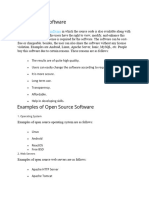0% found this document useful (0 votes)
19 views4 pagesOpen Source vs. Closed Source Software
The document discusses open source vs closed source software, explaining that open source software makes its source code publicly available for anyone to view or modify while closed source keeps its code private, with the majority of popular apps being closed source though there are open source alternatives. The pros of open source include it usually being free and allowing for quick fixes, while cons can include less stability and harder to find support.
Uploaded by
sunil.muduliCopyright
© © All Rights Reserved
We take content rights seriously. If you suspect this is your content, claim it here.
Available Formats
Download as DOCX, PDF, TXT or read online on Scribd
0% found this document useful (0 votes)
19 views4 pagesOpen Source vs. Closed Source Software
The document discusses open source vs closed source software, explaining that open source software makes its source code publicly available for anyone to view or modify while closed source keeps its code private, with the majority of popular apps being closed source though there are open source alternatives. The pros of open source include it usually being free and allowing for quick fixes, while cons can include less stability and harder to find support.
Uploaded by
sunil.muduliCopyright
© © All Rights Reserved
We take content rights seriously. If you suspect this is your content, claim it here.
Available Formats
Download as DOCX, PDF, TXT or read online on Scribd
/ 4






























































